Streamflow and Sediment Declines in a Loess Hill and Gully Landform Basin Due to Climate Variability and Anthropogenic Activities
Abstract
1. Introduction
2. Materials and Methods
2.1. Study Basin and Data
2.2. Trend Test and Abrupt Change Detection
2.3. Attribution Analysis Methods for Hydrological Changes
3. Results
3.1. Changes in Flood Season’s Climatic and Hydrological Variables
3.2. Separation of Pre- and Post-Impact Periods
3.3. Attribution of Streamflow and Sediment Declines
4. Discussion
- Basin-wide continuous rainfall process. Abundant rainfall amount makes the soil vadose zone fully saturated, and mountains with steep slopes may collapse into the channels becoming an important source of sediment during the flood events.
- High rainfall intensity events. It is an important driving factor for high sediment concentration process and dam-break floods. On China’s Loess Plateau, the rainfall thresholds (≥25 mm/day, ≥50 mm/day, ≥100 mm/day) often have strong positive correlations with streamflow and sediment load during extreme flood events. These thresholds are empirical values estimated by previous studies (e.g., [28,41]) from statistical analysis using large amounts of rainfall, sediment and streamflow data from multiple basins in the middle reaches of the Yellow River. Therefore, these thresholds are regional, related to the rainfall characteristics and the underlying soil, vegetation, and geomorphological features. Usually, statistical methods are used to establish the relationship between these thresholds and streamflow (or sediment yield), and then to make predictions.
- Dam-break records or unusual reservoir flood discharge records. When water or sand storage is greater than the reservoir (or warping dam) storage capacity, much more water or sand than normal would be released and even the hydrological projects may be damaged.
- The debris in the river channels. The debris (e.g., construction waste, garbage, landslide, illegal construction on the river beach) due to human activities or upstream drifting will cause the blockage of river channel, and further cause a concentrated release of water and sand.
5. Conclusions
Author Contributions
Funding
Conflicts of Interest
References
- Wang, S.; Fu, B.; Piao, S.; Lü, Y.; Ciais, P.; Feng, X.; Wang, Y. Reduced sediment transport in the Yellow River due to anthropogenic changes. Nat. Geosci. 2016, 9, 38–41. [Google Scholar] [CrossRef]
- Nilawar, A.P.; Waikar, M.L. Use of SWAT to determine the effects of climate and land use changes on streamflow and sediment concentration in the Purna River basin, India. Environ. Earth Sci. 2018, 77, 783. [Google Scholar] [CrossRef]
- Xiao, Z.; Liang, Z.; Li, B.; Hou, B.; Hu, Y.; Wang, J. New flood early warning and forecasting method based on similarity theory. J. Hydrol. Eng. 2019, 24, 04019023. [Google Scholar] [CrossRef]
- Wang, X. Advances in separating effects of climate variability and human activities on stream discharge: An overview. Adv. Water Resour. 2014, 71, 209–218. [Google Scholar] [CrossRef]
- Li, D.; Liang, Z.; Zhou, Y.; Li, B.; Fu, Y. Multicriteria assessment framework of flood events simulated with vertically mixed runoff model in semiarid catchments in the middle Yellow River. Nat. Hazards Earth Syst. Sci. 2019, 19, 2027–2037. [Google Scholar] [CrossRef]
- Gao, P.; Mu, X.M.; Wang, F.; Li, R. Changes in streamflow and sediment discharge and the response to human activities in the middle reaches of the Yellow River. Hydrol. Earth Syst. Sci. 2011, 15, 1–10. [Google Scholar] [CrossRef]
- Bao, Z.; Zhang, J.; Wang, G.; Fu, G.; He, R.; Yan, X.; Jin, J.; Liu, Y.; Zhang, A. Attribution for decreasing streamflow of the Haihe River basin, northern China: Climate variability or human activities? J. Hydrol. 2012, 460–461, 117–129. [Google Scholar] [CrossRef]
- Gao, Z.; Zhang, L.; Zhang, X.; Cheng, L.; Potter, N.; Cowan, T.; Cai, W. Long-term streamflow trends in the middle reaches of the Yellow River Basin: Detecting drivers of change. Hydrol. Proces. 2016, 30, 1315–1329. [Google Scholar] [CrossRef]
- Gao, G.; Zhang, J.; Liu, Y.; Ning, Z.; Fu, B.; Sivapalan, M. Spatio-temporal patterns of the effects of precipitation variability and land use/cover changes on long-term changes in sediment yield in the Loess Plateau, China. Hydrol. Earth Syst. Sci. 2017, 21, 4363–4378. [Google Scholar] [CrossRef]
- Li, B.; Liang, Z.; Zhang, J.; Wang, G.; Zhao, W.; Zhang, H.; Wang, J.; Hu, Y. Attribution analysis of runoff decline in a semiarid region of the Loess Plateau, China. Theor. Appl. Climatol. 2018, 131, 845–855. [Google Scholar] [CrossRef]
- Fu, B.; Wang, S.; Liu, J.; Liang, W.; Miao, C. Hydrogeomorphic ecosystem response to natural and anthropogenic changes in the Loess Plateau of China. Annu. Rev. Earth Planet. Sci. 2017, 45, 223–243. [Google Scholar] [CrossRef]
- Zhao, G.; Klik, A.; Mu, X.; Wang, F.; Gao, P.; Sun, W. Sediment yield estimation in a small watershed on the northern Loess Plateau, China. Geomorphology. 2015, 241, 343–352. [Google Scholar] [CrossRef]
- Chen, N.; Ma, T.; Zhang, X. Responses of soil erosion processes to land cover changes in the Loess Plateau of China: A case study on the Beiluo River basin. Catena 2016, 136, 118–127. [Google Scholar] [CrossRef]
- Zhao, G.; Mu, X.; Han, M.; An, Z.; Gao, P.; Sun, W.; Xu, W. Sediment yield and sources in dam-controlled watersheds on the northern Loess Plateau. Catena 2017, 149, 110–119. [Google Scholar] [CrossRef]
- Zhao, G.; Tian, P.; Mu, X.; Jiao, J.; Wang, F.; Gao, P. Quantifying the impact of climate variability and human activities on streamflow in the middle reaches of the Yellow River basin, China. J. Hydrol. 2014, 519, 387–398. [Google Scholar] [CrossRef]
- Wu, J.; Miao, C.; Yang, T.; Duan, Q.; Zhang, X. Modeling streamflow and sediment responses to climate change and human activities in the Yanhe River, China. Hydrol. Res. 2018, 49, 150–162. [Google Scholar] [CrossRef]
- Li, B.; Liang, Z.; Bao, Z.; Wang, J.; Hu, Y. Changes in streamflow and sediment for a planned large reservoir in the middle Yellow River. Land Degrad. Dev. 2019, 30, 878–893. [Google Scholar] [CrossRef]
- Tan, X.; Gan, T.Y. Contribution of human and climate change impacts to changes in streamflow of Canada. Sci. Rep. 2015, 5, 17767. [Google Scholar] [CrossRef]
- Zhao, Y.; Zou, X.; Gao, J.; Xu, X.; Wang, C.; Tang, D.; Wang, T.; Wu, X. Quantifying the anthropogenic and climatic contributions to changes in water discharge and sediment load into the sea: A case study of the Yangtze River, China. Sci. Total Environ. 2015, 536, 803–812. [Google Scholar] [CrossRef]
- Awotwi, A.; Anornu, G.K.; Quaye–Ballard, J.; Annor, T.; Forkuo, E.K. Analysis of climate and anthropogenic impacts on runoff in the Lower Pra River Basin of Ghana. Heliyon 2017, 3, e00477. [Google Scholar] [CrossRef]
- Restrepo, J.D.; Escobar, H.A. Sediment load trends in the Magalena River basin (1980–2010): Anthropogenic and climate-induced causes. Geomorphology 2018, 302, 76–91. [Google Scholar] [CrossRef]
- Pokhrel, Y.; Burbano, M.; Roush, J.; Kang, H.; Sridhar, V.; Hyndman, D.W. A review of the integrated effects of changing climate, land use, and dams on Mekong River hydrology. Water 2018, 10, 266. [Google Scholar] [CrossRef]
- Yang, X.; Sun, W.; Li, P.; Mu, X.; Gao, P.; Zhao, G. Reduced sediment transport in the Chinese Loess Plateau due to climate change and human activities. Sci. Total Environ. 2018, 642, 591–600. [Google Scholar] [CrossRef] [PubMed]
- Yan, R.; Zhang, X.; Yan, S.; Zhang, J.; Chen, H. Spatial patterns of hydrological responses to land use/cover change in a catchment on the Loess Plateau, China. Ecol. Indic. 2018, 92, 151–160. [Google Scholar] [CrossRef]
- Liang, W.; Bai, D.; Wang, F.; Fu, B.; Yan, J.; Wang, S.; Yang, Y.; Long, D.; Feng, M. Quantifying the impacts of climate change and ecological restoration on streamflow changes based on a Budyko hydrological model in China’s Loess Plateau. Water Resour. Res. 2015, 51, 6500–6519. [Google Scholar] [CrossRef]
- Tian, P.; Mu, X.; Liu, J.; Hu, J.; Gu, C. Impacts of climate variability and human activities on the changes of runoff and sediment load in a catchment of the Loess Plateau, China. Adv. Meteorol. 2016, 2016. [Google Scholar] [CrossRef]
- Zhao, G.; Mu, X.; Jiao, J.; Gao, P.; Sun, W.; Li, E.; Wei, Y.; Huang, J. Assessing response of sediment load variation to climate change and human activities with six different approaches. Sci. Total Environ. 2018, 639, 773–784. [Google Scholar] [CrossRef]
- Liu, X. Cause of Water and Sediment Sharp Decline in the Yellow River in Recent Years; Science Press: Beijing, China, 2016. (In Chinese) [Google Scholar]
- Li, J.; Liu, L. Analysis on the sediment retaining amount by warping dams above Tongguan section of the Yellow River in recent years. Yellow River 2018, 40, 1–6. (In Chinese) [Google Scholar]
- Mann, H.B. Nonparametric tests against trend. Econometric 1945, 13, 245–259. [Google Scholar] [CrossRef]
- Kendall, M.G. Rand Correlation Methods; Charles Griffin: London, UK, 1975. [Google Scholar]
- Yue, S.; Pilon, P.; Phinney, B.; Cavadias, G. The influence of autocorrelation on the ability to detect trend in hydrological series. Hydrol. Process. 2002, 16, 1807–1829. [Google Scholar] [CrossRef]
- Xie, P.; Chen, G.; Li, D.; Zhu, Y. Comprehensive diagnosis method of hydrologic time series change-point analysis. Water Resour. Power 2005, 23, 11–14. (In Chinese) [Google Scholar]
- Dai, M.Y. Runoff estimation model based on the separation from its cause of formation. In Study of Changes in Runoff and Sediment Load in the Yellow River; Wang, G., Fan, Z., Eds.; The Yellow River Water Conservancy Press: Zhengzhou, China, 2002; Volume 1, pp. 981–990. (In Chinese) [Google Scholar]
- Dai, M.Y. Water and sediment changes and the calculation comparison of hydrological methods in the Wuding River basin. In Study of Changes in Runoff and Sediment Load in the Yellow River; Wang, G., Fan, Z., Eds.; The Yellow River Water Conservancy Press: Zhengzhou, China, 2002; Volume 1, pp. 991–1009. [Google Scholar]
- Willmott, C.J. On the validation of models. Phys. Geogr. 1981, 2, 184–194. (In Chinese) [Google Scholar] [CrossRef]
- Xie, P.; Gu, H.; Sang, Y.F.; Wu, Z.; Singh, V.P. Comparison of different methods for detecting change points in hydroclimatic time series. J. Hydrol. 2019, 577, 123973. [Google Scholar] [CrossRef]
- Li, B.; Yu, Z.; Liang, Z.; Song, K.; Li, H.; Wang, Y.; Zhang, W.; Acharya, K. Effects of climate variations and human activities on runoff in the Zoige alpine wetland in the eastern edge of the Tibetan Plateau. J. Hydrol. Eng. 2014, 19, 1026–1035. [Google Scholar] [CrossRef]
- Cui, T.; Yang, T.; Xu, C.; Shao, Q.; Wang, X.; Li, Z. Assessment of the impact of climate change on flow regime at multiple temporal scales and potential ecological implications in an alpine river. Stoch. Environ. Res. Risk Assess. 2018, 32, 1849–1866. [Google Scholar] [CrossRef]
- Wang, X.; Yang, T.; Yong, B.; Krysanova, V.; Shi, P.; Li, Z.; Zhou, X. Impacts of climate change on flow regime and sequential threats to riverine ecosystem in the source region of the Yellow River. Environ. Earth Sci. 2018, 77, 465. [Google Scholar] [CrossRef]
- Wang, G.; Fan, Z. Study of Changes in Runoff and Sediment Load in the Yellow River; The Yellow River Water Conservancy Press: Zhengzhou, China, 2002. (In Chinese) [Google Scholar]
- Xu, J. Variation in annual runoff of the Wudinghe River as influenced by climate change and human activity. Quat. Int. 2011, 244, 230–237. [Google Scholar] [CrossRef]
- Zhao, G.; Kondolf, G.M.; Mu, X.; Han, M.; He, Z.; Rubin, Z.; Wang, F.; Gao, P.; Sun, W. Sediment yield reduction associated with land use changes and check dams in a catchment of the Loess Plateau, China. Catena 2017, 148, 126–137. [Google Scholar] [CrossRef]
- Zhao, T.; Yang, M.; Walling, D.E.; Zhang, F.; Zhang, J. Using check dam deposits to investigate recent changes in sediment yield in the Loess Plateau, China. Glob. Planet. Chang. 2017, 152, 88–98. [Google Scholar] [CrossRef]
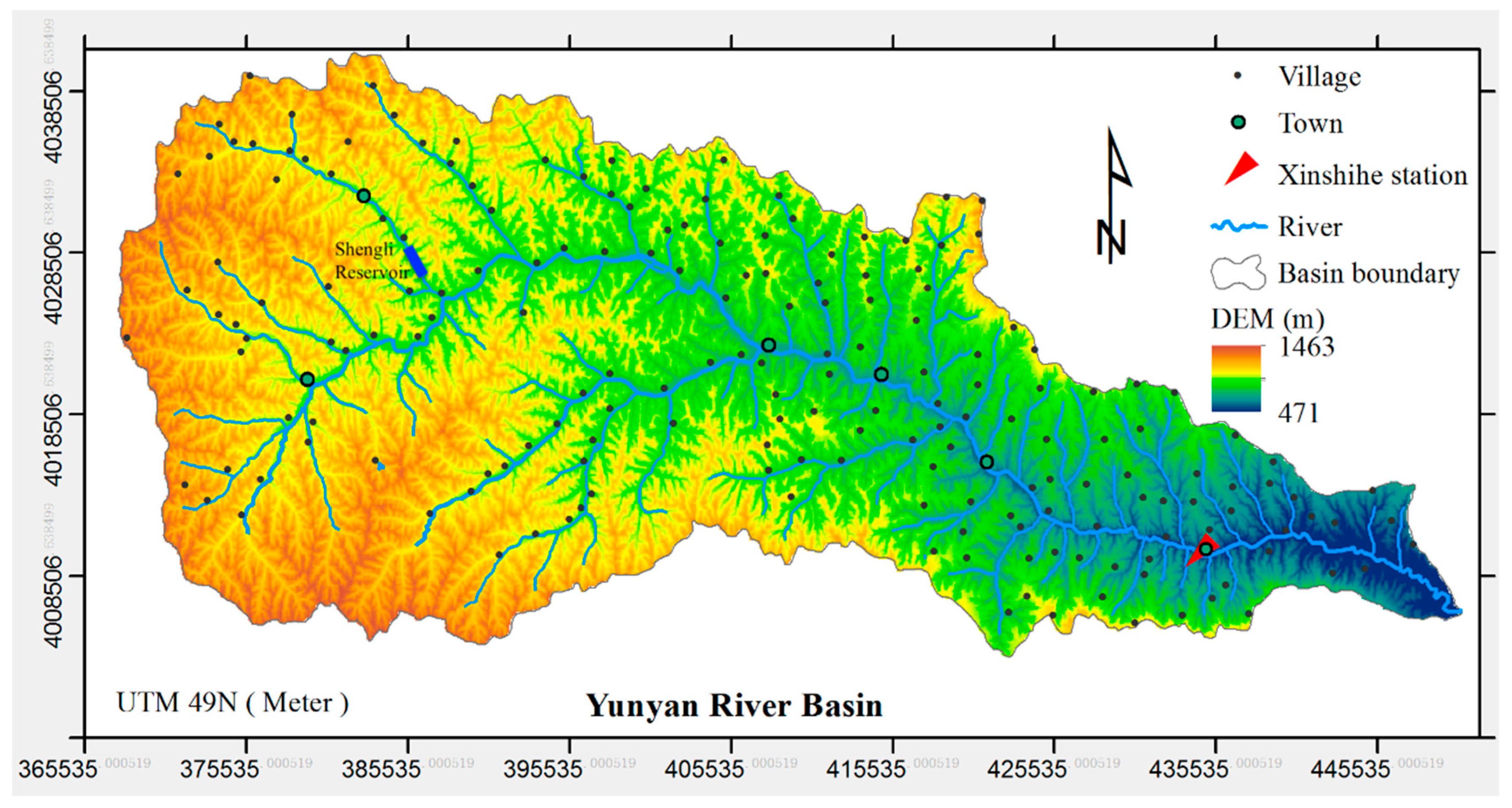
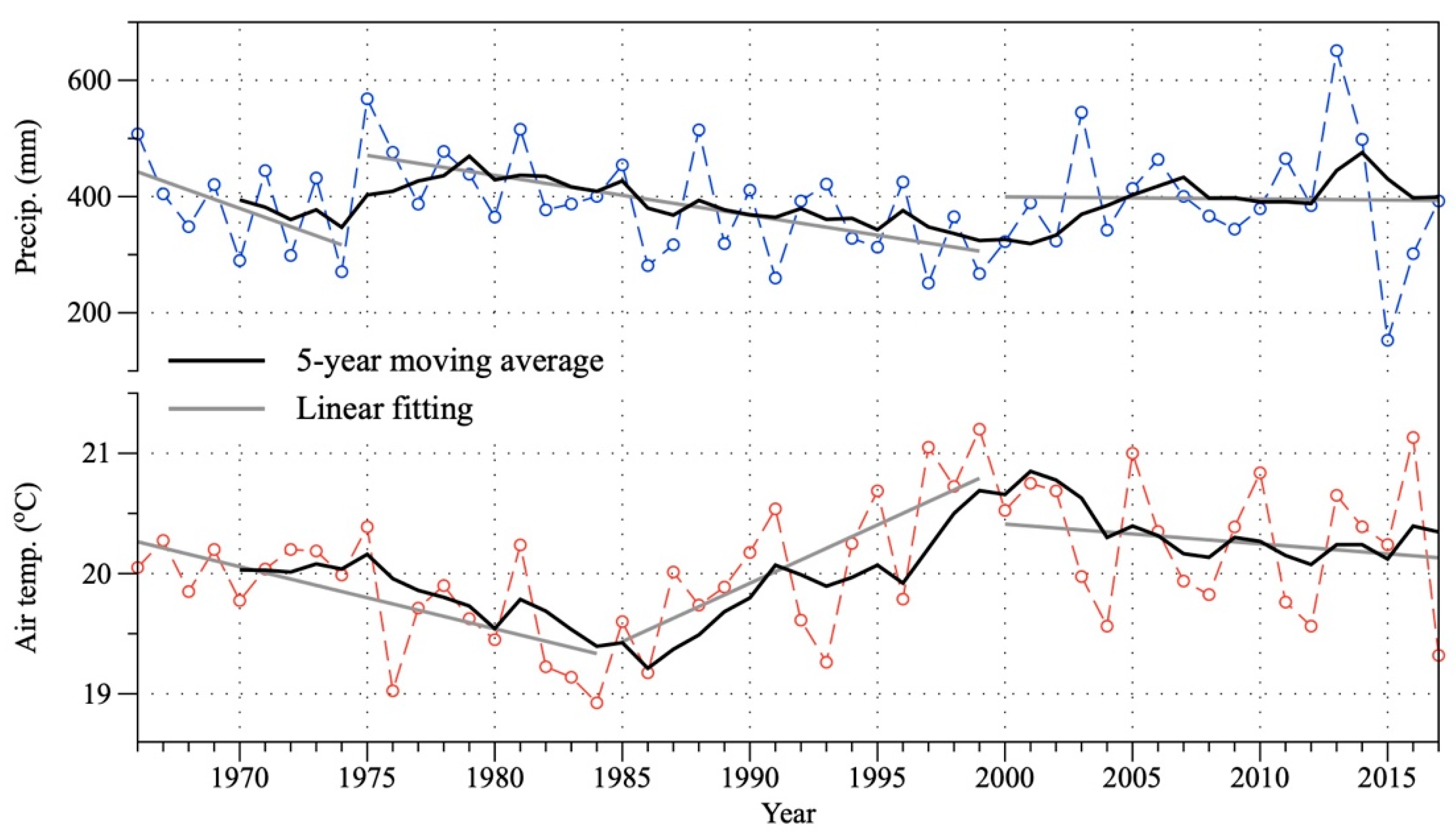
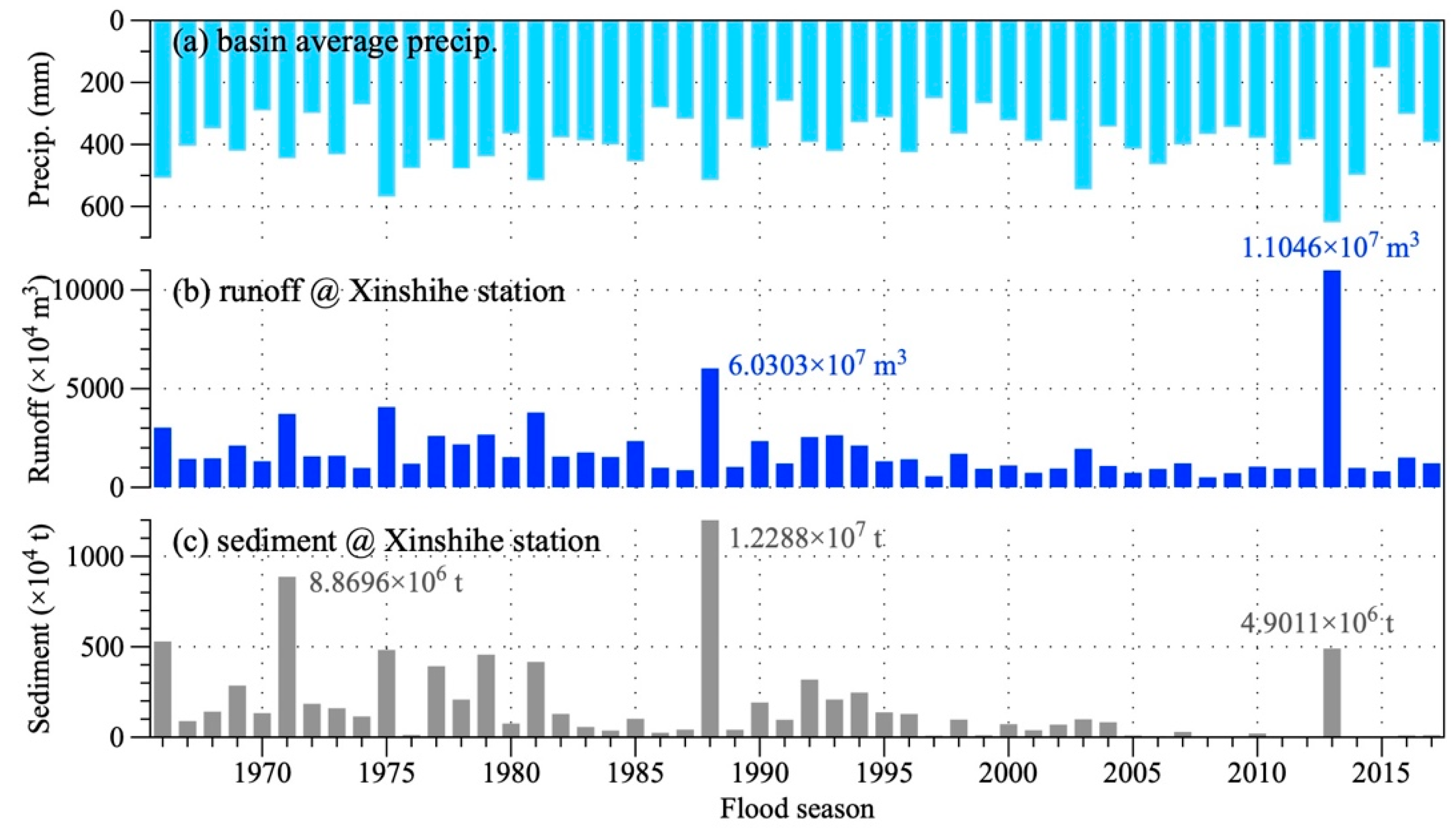
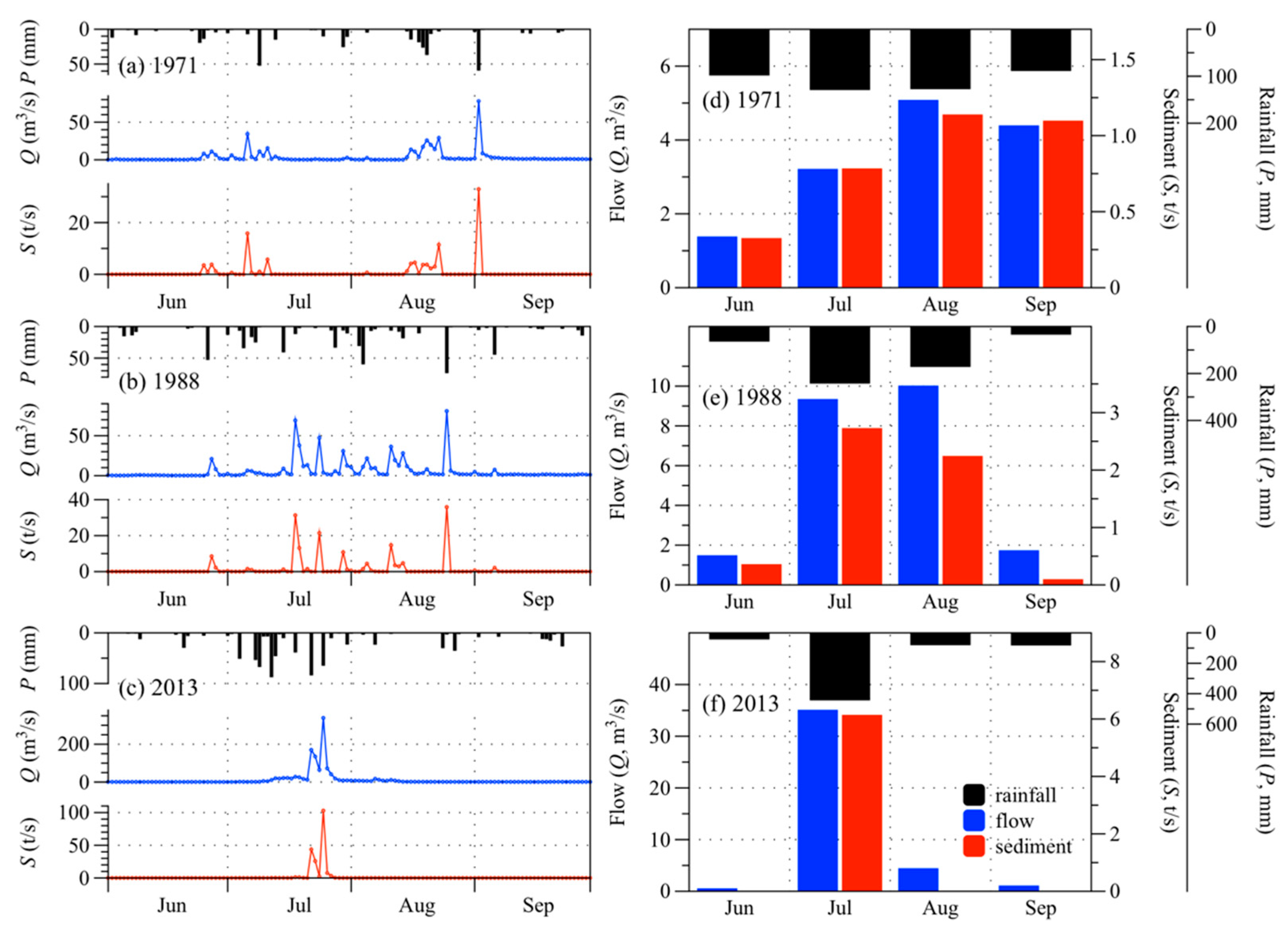
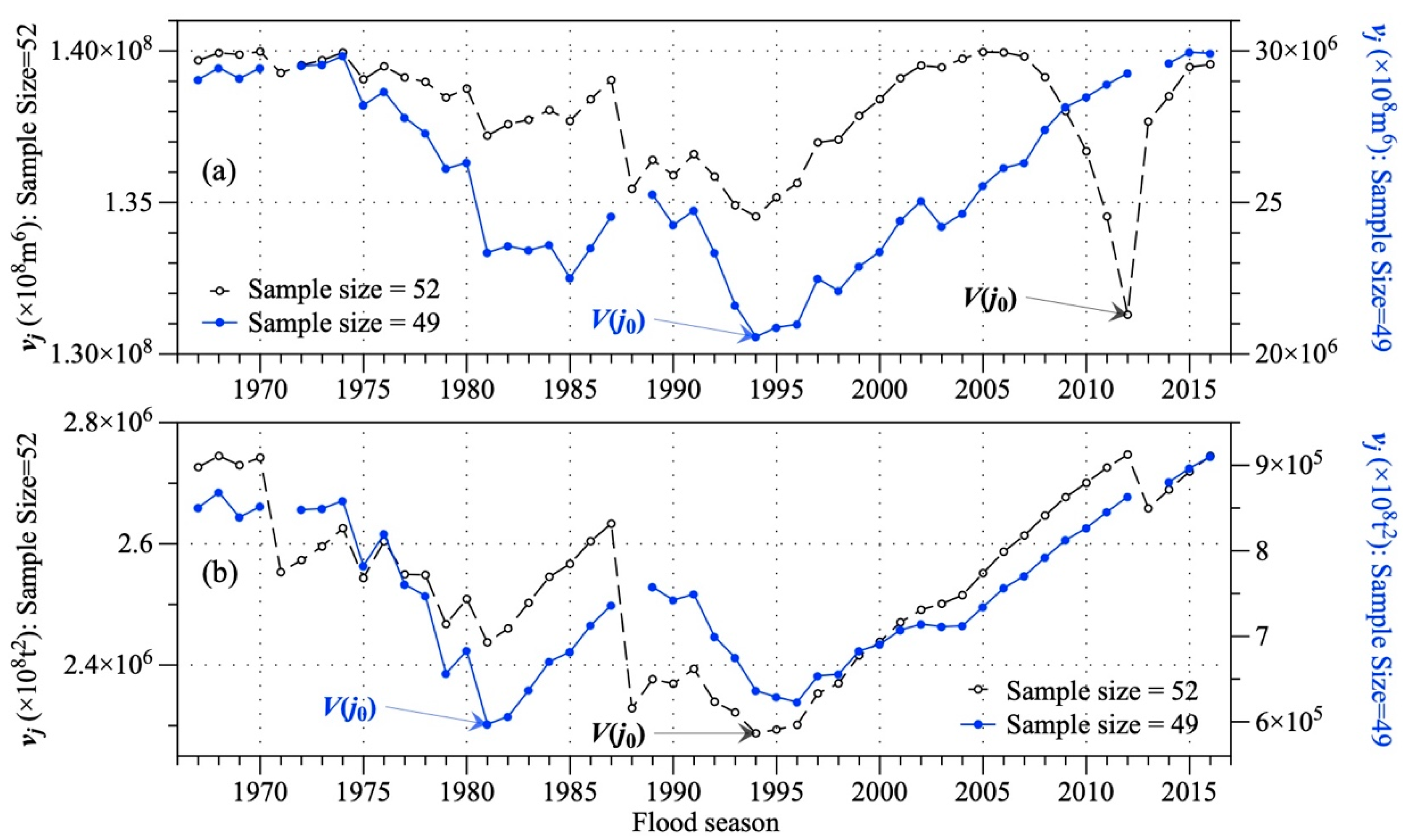

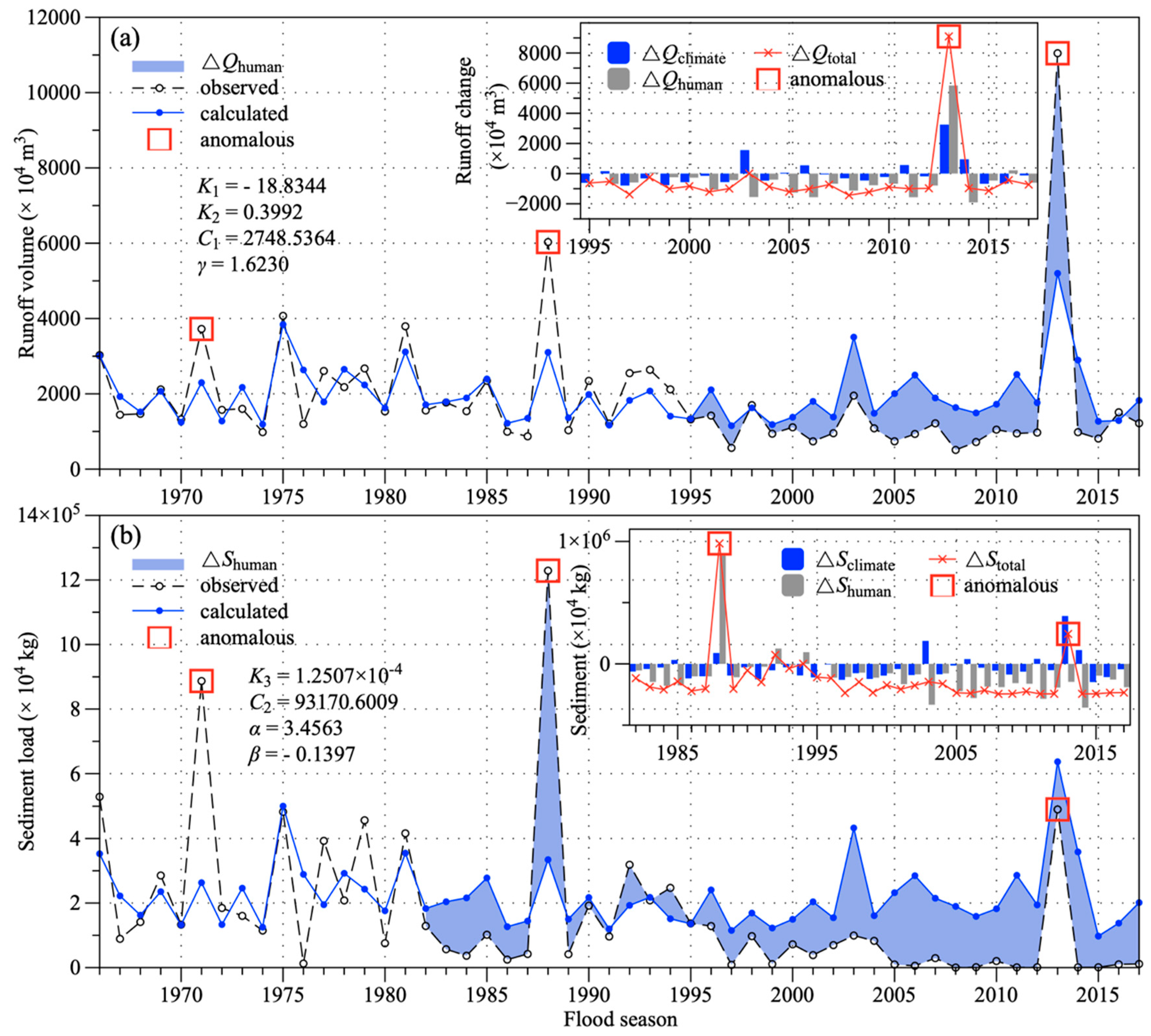
| Erosion-Prone Area (km2) | Forest/Pasture Coverage of Erosion-Prone Area (%) | Forest/Pasture Area in 2014 (km2) 1 | |||
|---|---|---|---|---|---|
| 1970s | 2014 | Total Area | Coverage > 30% | Coverage > 50% | |
| 1704 | 66.0 | 81.2 | 1537 | 1533 | 1520 |
| Terrace in 2014 (km2) | Warping Dam land in 2011 (km2) | Effective Warping Dam in 2011 | Composite Coverage (%) 3 | ||
| Number | Controlling Area Ratio (%) 2 | ||||
| 22.8 | 25.33 | 31 | 4.4 | 84.0 | |
| Post-Impact Period | Total Change (×104 kg/flood-season) | Climatic Contribution | Anthropogenic Contribution |
|---|---|---|---|
| 1982–1996 | −119,708.7 | 51.2% | 48.8% |
| 1997–2017 | −216,940.0 | 19.9% | 80.1% |
| 1982–2017 | −176,903.5 | 28.6% | 71.4% |
© 2019 by the authors. Licensee MDPI, Basel, Switzerland. This article is an open access article distributed under the terms and conditions of the Creative Commons Attribution (CC BY) license (http://creativecommons.org/licenses/by/4.0/).
Share and Cite
Chang, Q.; Zhang, C.; Zhang, S.; Li, B. Streamflow and Sediment Declines in a Loess Hill and Gully Landform Basin Due to Climate Variability and Anthropogenic Activities. Water 2019, 11, 2352. https://doi.org/10.3390/w11112352
Chang Q, Zhang C, Zhang S, Li B. Streamflow and Sediment Declines in a Loess Hill and Gully Landform Basin Due to Climate Variability and Anthropogenic Activities. Water. 2019; 11(11):2352. https://doi.org/10.3390/w11112352
Chicago/Turabian StyleChang, Qingrui, Chi Zhang, Song Zhang, and Binquan Li. 2019. "Streamflow and Sediment Declines in a Loess Hill and Gully Landform Basin Due to Climate Variability and Anthropogenic Activities" Water 11, no. 11: 2352. https://doi.org/10.3390/w11112352
APA StyleChang, Q., Zhang, C., Zhang, S., & Li, B. (2019). Streamflow and Sediment Declines in a Loess Hill and Gully Landform Basin Due to Climate Variability and Anthropogenic Activities. Water, 11(11), 2352. https://doi.org/10.3390/w11112352






